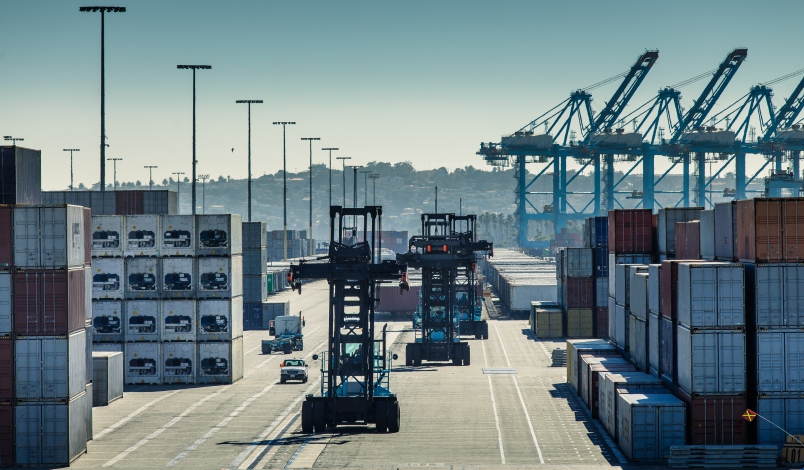
Public and private sector leaders look to regulatory measures to relieve supply chain pressures likely to affect post-Thanksgiving sales.
The average cost of food rose 5.4 percent in the last 12 months, with the cost of poultry increasing by 11.9 percent. Turkeys, mashed potatoes, stuffing, and other common Thanksgiving foods will cost more this year for most families in the United States.
And when shoppers take to the stores to look for holiday gifts on the day after Thanksgiving, they are likely also to find higher prices—and even some empty shelves—due to shipping delays and inventory shortages that have followed from the global pandemic.
In many parts of the world, including the United States, supply chains are still struggling to rebound to their pre-pandemic levels of efficiency. It will take time to restore the efficiency of the vast, complex networks of producers, vendors, warehouses, transportation companies, distribution centers, and retailers that enable goods to reach consumers. But, according to policymakers and industry leaders, temporary changes to regulations may help speed the recovery along.
In June, the Biden Administration released a report outlining numerous policy actions that federal agencies are taking to help restore supply chain vitality and speed. In October, the White House announced a specific plan to address operational bottlenecks at two ports in California that receive 40 percent of containers shipped to the United States: the Port of Los Angeles and the Port of Long Beach. This plan expanded operations at these ports to 24 hours a day, seven days a week—just like ports operating in other countries.
In coordination with this plan, Walmart, UPS, FedEx, Samsung, The Home Depot, and Target have also committed to increasing their operations to help move goods through the ports. In addition, the International Longshore and Warehouse Union (ILWU) announced that its members––who work at the ports as longshoremen, mechanics, marine clerks, foremen, and guards––will perform extra shifts to provide 24/7 coverage at the ports.
The Administration claims that “these commitments will help unlock capacity in the rest of the system—including highways, railroads, and warehouses—by reducing congestion during the day.” Some industry insiders, however, are skeptical. Michael Farlekas, the CEO of a supply chain software firm, reportedly doubts that extended port hours will by themselves “materially move the needle.”
Federal shipping regulations are one overarching structural feature said to be exacerbating the delays. Under the Jones Act, the U.S. domestic maritime industry can only operate with ships built in the United States. As a result, U.S. fleets tend to contain older, inefficient ships that operate long past their prime, which drives up overhead and construction costs.
One major problem facing port operations today stems from the accumulation of empty shipping containers—they are simply running out of space to put new containers. To try to clear the backlog of empty containers, the ports have recently approved industry-developed rules for processing of shipping containers as well as imposed a system for imposing fines when empty containers sit in port for more than nine days.
These efforts appear to be making some difference. Port officials report a drop in the number of empty containers sitting around the ports.
But moving past the pandemic-induced supply chain disruption will require more than just recalibrating port operations. U.S. Secretary of Agriculture Tom Vilsack has stated that “the coronavirus pandemic has impacted every stage” of the U.S. food supply chain “from commodity production through processing and delivery.”
For example, truck drivers transport 71 percent of the goods in the U.S. economy. The trucking industry, however, is short about 80,000 drivers—a deficit that increased by 30 percent during the pandemic. This labor shortage in the trucking industry has contributed to the unprecedented cargo backlogs at U.S. ports.
Due to regulatory limits on the number of hours truck drivers can work at a given stretch—put in place for safety reasons—trucking firms cannot easily make up for the shortfall in drivers just by paying overtime. And hiring new truck drivers also requires navigating a regulatory licensing process that can take some time. In response, a group of twelve Republican governors have called for temporary suspension of a variety of regulations imposed on the trucking industry.
Temporary changes to state and local regulations might also help in speeding up the supply chain, according to some commentators.
About 20 business groups have written to California Governor Gavin Newsom, asking him to declare a state of emergency and suspend certain labor and environmental regulations which they claim interfere with efforts to restart supply networks. These groups argue that only increasing port operation “will do little without immediate action from the state to address other barriers that have created bottlenecks at the ports, warehouses, trucking, rail, and the entire supply chain.”
Even as various public and private efforts continue to work to restore the supply chain to its pre-pandemic operations, policymakers are also looking forward toward the future. Earlier this month, Congress passed the Infrastructure Investment and Jobs Act, which provides for port upgrades to strengthen the U.S. supply chain “and prevent disruptions that have caused inflation.” The new law also allocates funding to develop the trucking workforce.
These various actions being taken today show a desire by public officials as well as business leaders not only to restoring the U.S. supply chain but hopefully transforming it ensure affordable prices for turkey, sweet potato pie, and holiday gifts for years to come.
For our readers who celebrate Thanksgiving: The Regulatory Review wishes you a happy, safe, and healthy holiday!



